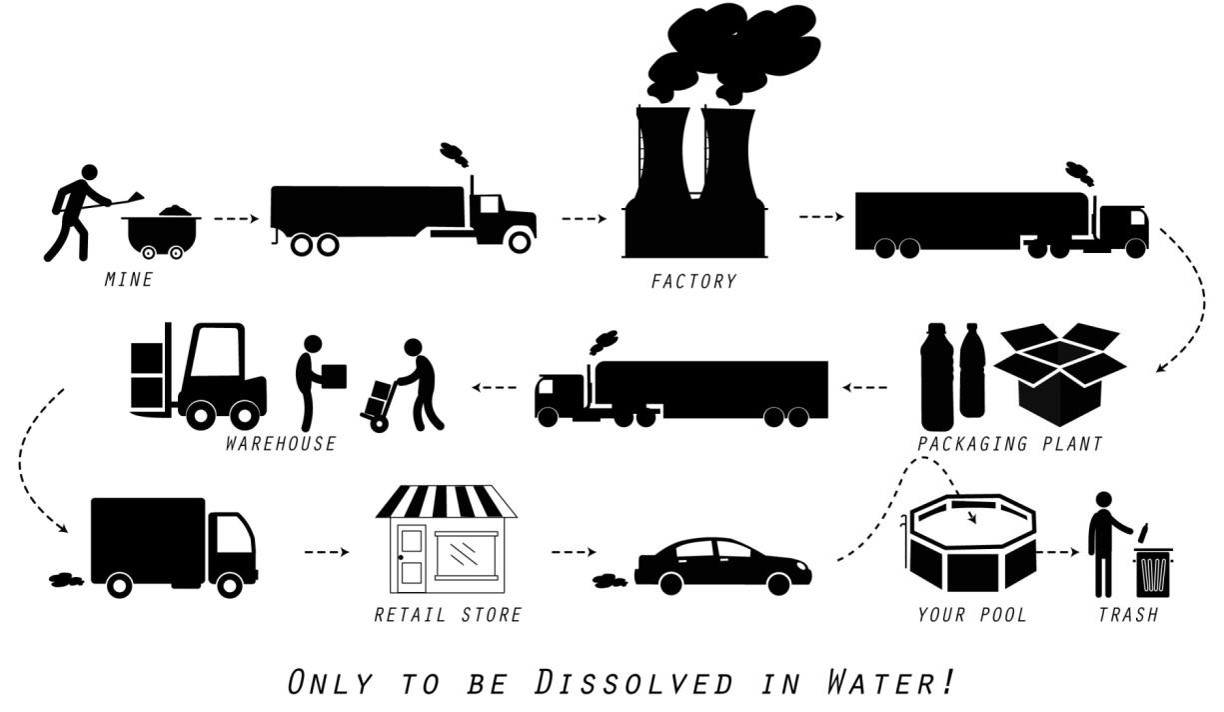The Future for Pools?

 To gain a larger perspective on what tomorrow holds for our planet and our watershapes, writesJames Robyn, start by looking beyond our day-to-day lives to see what history, science and astronomy can tell us — then consider what it’ll take to ensure a long, safe, prosperous future.
To gain a larger perspective on what tomorrow holds for our planet and our watershapes, writesJames Robyn, start by looking beyond our day-to-day lives to see what history, science and astronomy can tell us — then consider what it’ll take to ensure a long, safe, prosperous future.
It’s common these days to hear people talking about the planet Mars, and for good reason: Our continued existence on our home planet is the subject of intense scientific and political discussion, and many who are concerned about our future here have started speculating about the potential Mars might have as a refuge for the human race.
Curious about how far this sort of thinking had gone, I uploaded a post to a scientists’ discussion group not long ago asking what it would be like to swim in a pool on Mars. The lower gravity would, of course, make a huge and obvious difference, someone replied, because Mars has just a third of the gravitational pull familiar to us on Earth. But while the process of swimming would be unchanged, diving in and getting out would be totally different – and wave motion and splashing effects would be weirdly unfamiliar as well.
These discussions reminded me of the curiosity about Venus that dominated kids’ imaginations when I was growing up in the 1950s. That planet is the third brightest object in our sky (after the sun and the moon) and has often been referred to as Earth’s twin because it’s very close to our planet in size, has about the same mass and, at half the distance away from us as Mars, is definitely our closest planetary neighbor.
Those facts are fine and fun, but it turns out that Venus may also suggest our earthly future if we don’t manage to become better stewards of our fragile planet. And that stewardship, I’ve recognized in recent years, extends all the way over to what we do as watershape designers and builders.
PLANETARY INTERESTS
The interesting thing about Earth, Mars and Venus is that they all formed from the same cosmic stuff about 4.5 billion years ago – and a lot of that stuff in all three cases was water. Indeed, the National Aeronautics & Spa Administration (NASA) figures that for its first two billion years, Venus was a blue planet with a water ocean and land masses similar to Earth’s.
Today, however, Venus is a hellish place. Its atmosphere is 90 times thicker than Earth’s with a surface pressure that’s the rough equivalent of being crushed under 3,000 feet of water in one of our oceans. And it gets worse: The atmosphere is made up of carbon dioxide and sulfuric acid that falls as rain to a surface that clocks in at 870 degrees Fahrenheit – hot enough to melt lead.
| NASA’s depiction of what Venus might have looked like 3 billion years ago. |
Being flattened by the weight of the atmosphere while simultaneously being parboiled by the heat and pitted by acid rain? It’s not an invitation to go swimming, and I see no future for landscape architects or pool professionals on Venus – or anyone else, for that matter.
But Venus is still intriguing. Back in 1960, the astronomer Carl Sagan – then a Ph.D. candidate – figured out that Earth’s twin had become so awful because at some point it had experienced a runaway greenhouse-gas effect. Venus was particularly and cruelly susceptible to such a cascading catastrophe because it is so close to the sun, he wrote, but the sad fact is that it started out with about the same amounts of water and carbon as Earth did and held onto them in harmless forms for a long time.
But gradually, rising surface temperatures made more carbonates vaporize out of Venusian rock in the form of carbon dioxide – resulting in warmer oceans that caused more water vapor (another greenhouse gas) to enter the atmosphere and warm things further, which in turn resulted in more carbon dioxide vaporizing from rock. Ultimately, this cycle went off the rails: The oceans finally evaporated and further stoked the level of atmospheric water vapor, which increased carbon dioxide levels. As a result, the planet’s temperature spiraled up with devastating results.
Sagan demonstrated that, given time and inaction, increasing carbon dioxide levels in our own atmosphere would eventually result in a Venus-like explosion of greenhouse gases. More research into the dynamics of our neighbor’s atmosphere might prove helpful, but none of the spacecraft we’ve landed on Venus have survived for more than about two hours, the upshot being that we haven’t bothered to send any since the early 1980s.
Twenty years passed before Sagan followed his Ph.D. thesis up with Cosmos, a 1980 best-seller about the universe in which he wrote, “The principal energy sources of our present industrial civilization are the so-called fossil fuels. We burn wood and oil, coal and natural gas, and, in the process, release waste gases, principally [carbon dioxide], into the air.
“Consequently, the carbon dioxide content of the Earth’s atmosphere is increasing dramatically. The possibility of a runaway greenhouse effect suggests that we have to be careful: Even a one- or two-degree rise in the global temperature can have catastrophic consequences.
“The surface environment of Venus is a warning: Something disastrous can happen,” he concluded, “to a planet rather like our own.”
DOWN TO EARTH
How prescient was Carl Sagan back in 1980? Well, it is now universally accepted by the scientific community that global warming, also known as climate change, is a dangerous reality.
According to scientific surveys, the Earth’s global temperature has increased by 0.72 degrees Celsius (1.3 degrees Fahrenheit) since 1880. The ten warmest years ever recorded on Earth have all occurred since 2000, and the warmest ever was 2016. This warmer weather may be an inducement to buy swimming pools, but I think we can all agree that a cooked planet would be an unhappy place.
Unfortunately, all of this has become a game of political football rather than a scientific or practical discussion, and the controversy has limited the public’s willingness and determination to stop pumping carbon dioxide into the atmosphere despite the fact that continuing to do so, scientists say, is both unsustainable and essentially suicidal.
In November 2016, renowned physicist Stephen Hawking said that we only had 1,000 years left on this planet before we’d need to find somewhere else to live. Given that the pyramids were built 4,500 years ago, that’s relatively little time. But then last May, analyzing new data, Hawking knocked a zero off his prediction and gave us just100years.
| According to data from NASA and other scientific surveys, the Earth’s global temperature has increased by 0.72 degrees Celsius (1.3 degrees Fahrenheit) since 1980 (right). In the 140-odd years since 1880, the ten warmest on record have all occurred since 2000 – and the warmest ever was 2016 (just below). |
Let’s all hope that he’s very, very wrong. But let us also accept the fact that if we do nothing, we’re cooked, and that even with massive action, we likely will be scalded. I certainly hope that won’t be the case, but the dire nature of the prediction makes me want to do all I can to slow the increase of carbon emissions in the here and now.
One possible and immediate path to changing the predicament we’re in would be through implementation of a carbon tax. Several European countries have already enacted such measures, including Denmark, Finland, Ireland, the Netherlands, Norway, Slovenia, Sweden, Switzerland and the United Kingdom. Finland was the first, back in 1990, and it’s no surprise because, with vanishing glaciers and thawing permafrost, they’ve had ring-side seats when it comes to observing the effects of planetary warming.
Carbon taxes start at the source, with fees charged to oil, gas and coal producers based on how many tons of carbon they remove from the Earth and then process for downstream consumption that ends up releasing carbon dioxide into the atmosphere. Fees these companies pay are generally passed along to consumers, and that means higher pricing for carbon-intensive energy products (electricity, gasoline) and products made using energy-intensive processes (chemicals, pharmaceuticals, food).
Consumers who shun carbon-taxed products or find alternatives will save money. In fact, consumers who are already mindful of energy consumption will have even stronger economic and philosophical motivation to seek out and use those alternatives.
POOL FACTORS
For the pool industry, a carbon tax will mean an increasing demand for energy-efficient pumps and motors; for hydraulic designs that increase the efficiency of circulation and filtration systems; and for reduced dependency on electrically driven ancillary devices including ionizers and ozone or salt chlorine generators.
These represent substantial changes, but on the efficiency side at least, there’s already movement in that direction through use of variable-speed pumps. And let’s not forget the reach of a carbon tax, which will also raise costs for various pool chemicals because of increased expenses associated with manufacturing and transporting those products.
| Costs for pool-related chemicals are far from immune to increasing costs associated with the manufacture and transport of those materials as they move from the ground, progress into factories and get converted into usable form. Then there’s packaging and labeling, passage to distribution centers and finally, arrival in retail stores – after which consumers dissolve them in pool water. |
As with energy supplies, the chemical taxation chain starts with carbon-related expenses in the extraction of the raw materials, encompasses the transportation of those raw materials to a factory or processing plant and then includes the costs of conversion of the raw materials into usable pool chemicals from chlorine and algicides to pH buffers, pH adjusters, water clarifiers, chelating agents, borates, phosphate removers and more. Then come upcharges for packaging and labeling of the chemicals, transportation of the chemicals to distribution centers and, finally, transfers to retail stores where poolowners acquire them and ultimately disperse them into their pool water.
| The natural pool in Webber Park (Minneapolis, Minn.) has a 21,000-square-foot swimming zone and a separate 16,000-square-foot regeneration zone. This was the first public natural swimming pool in North America. |
 In today’s marketplace, most poolowners and buyers are only slightly concerned about the operating costs of their watershapes and fewer still ever consider the full lifecycle costs described above. But a time for that granular attention is coming, carbon taxes or not, because economic and environmental motivations for paying attention are increasing even without implementation of a carbon tax.
In today’s marketplace, most poolowners and buyers are only slightly concerned about the operating costs of their watershapes and fewer still ever consider the full lifecycle costs described above. But a time for that granular attention is coming, carbon taxes or not, because economic and environmental motivations for paying attention are increasing even without implementation of a carbon tax.
I’m a scientist by education and training, and my observations of all of these phenomena – climate change, tax issues, pricing pressures and all the rest – is what led me many years ago to explore the design and production of natural swimming pools as a component of my business. Simply put, it’s a way of looking at pools that essentially eliminates chemical consumption and many of the other cost factors involved in purchasing and sustaining a watershape.
Who among potential owners doesn’t like the thought of using no chemicals; of unpressurized circulation systems that run inexpensively as a result of lower head pressures and flow rates; of dramatically reduced energy consumption and costs; and of a significantly smaller carbon footprint? From my perspective, it seemed like the sort of responsible, good-steward concept I should pursue.
| These natural pools are found in backyards in Princeton, N.J. (left), and Newtown, Conn. (below). |
The pattern had been set in Europe, where already-high energy costs have long driven the demand for lower-initial-cost, lower-long-term-cost alternatives to conventional swimming pools. In fact, by the time I became involved, many pool renovations there were including conversion to the natural swimming pool approach, and at this point in Germany, Switzerland and Austria, approximately 17 percent of all new residential installations are natural swimming pools.
European landscape architects and pool designers have been promoting the concept for years. And natural swimming pool advocates are not alone back here in the United States: For years, pond builders have used bog filtration to simplify maintenance of their ponds and, in the process, significantly lower the costs of operating and maintaining these vessels while, whether they recognize it or not, significantly reducing their carbon footprints.
Some of these ponds boast gin-clear water and can be used in the same way as natural swimming pools, with plants and beneficial bacteria cleaning and clearing the water in place of filter tanks and chemicals.
BRINGING IT HOME
There’s no avoiding the fact that I’m an interested party in this discussion: Natural swimming pools are part of my business, and I do all I can to persuade prospective clients that they’re a great option. But this isn’t a proprietary approach: It’s always been an open-book strategy, and all it takes to get involved is a willingness to learn the ropes and apply that information in the field.
Our clients aren’t that different from typical high-end prospects other than in the fact that they consciously and deliberately want to buy products that are socially and environmentally responsible. Cost isn’t a factor; instead, it’s about their health, environmental, social and ecological sensibilities. This is why we engage so often with landscape architects: They, too, are looking for “green” approaches because they, too, tend to look at the world with a steward’s eye, seeking opportunities to define their clients as responsible citizens who are doing all they can to be good to the planet.
But if tree-hugging isn’t your ambition, look at it this way: As the cost of carbon-intensive energy inevitably escalates, financial considerations will encourage prospective poolowners to consider approaches that step back from intensive energy and chemical use. It’s already happening in agriculture; it’s also happening in construction, where local sourcing, recycling and sustainability are becoming guiding principles.
If that’s not enough, consider this: A warming climate will deepen the existing trend among families to vacation in their own backyards. That “staycation” principle is already a prime motivator in pool purchases, and it will grow in intensity as fuel, material and transportation costs all rise and traveling to resorts becomes less affordable and desirable.
As I see it, where conventional pools are verging on becoming part of the problem, natural pools are looking like a future solution. Food for thought?
James G. Robyn is president and CEO of BioNova Natural Pools and of Rin Robyn Pools in Chester, N.J. A second-generation pool designer/builder, he holds a bachelor’s degree in astrogeophysics from Colgate University and a master’s degree in business administration and international management. Robyn is an instructor for Genesis University, an affiliate member and instructor in the American Society of Landscape Architects, a member of the Association of Pool & Spa Professionals, president of the Association for Swimming Ponds & Natural Swimming Pools and a board director for the International Organization for Natural Bathing Water (IOB). He may be reached at james@bionovanaturalpools.com.
















